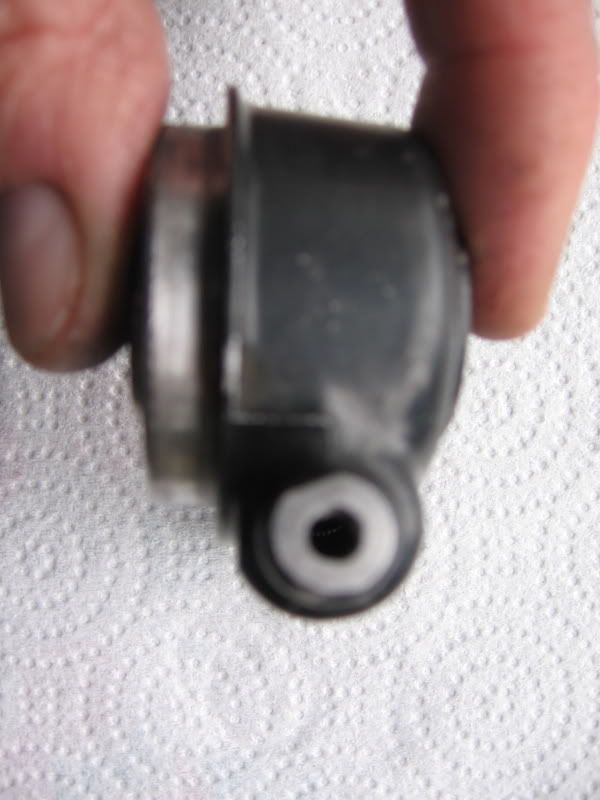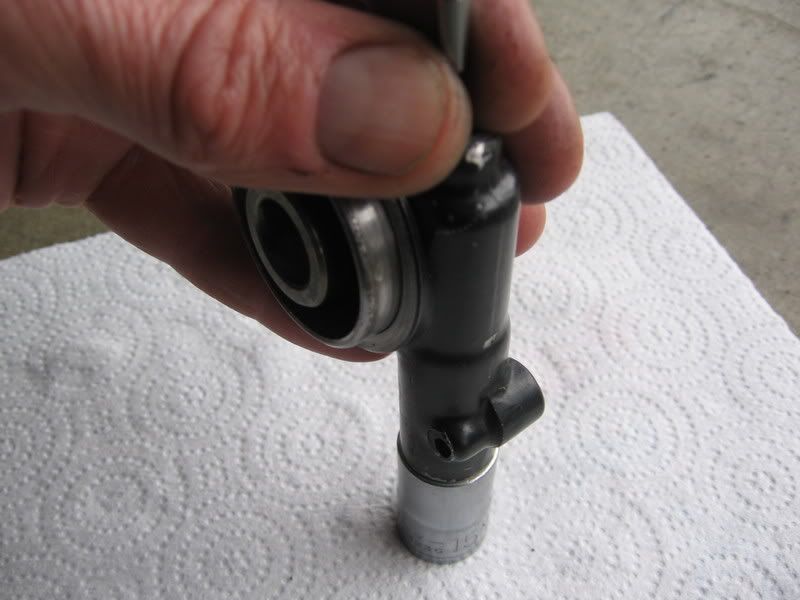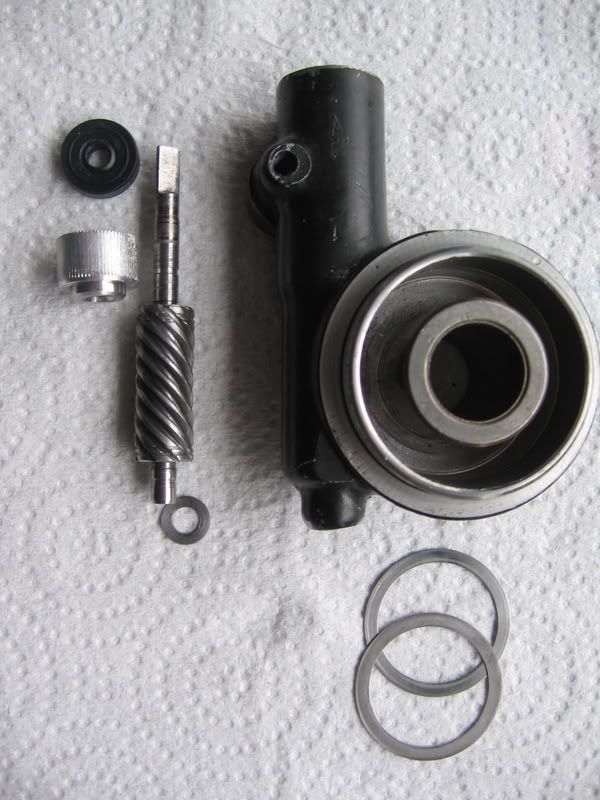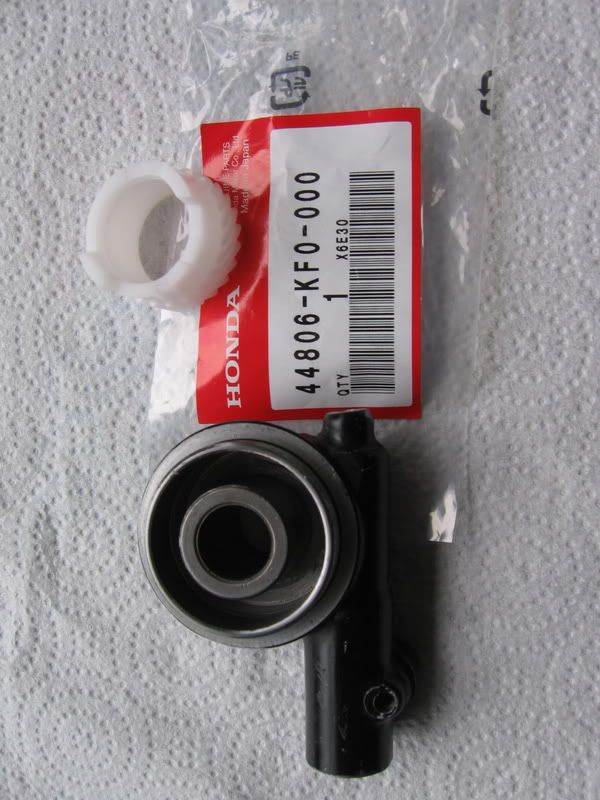Riding Monday and the speedo needle starts vibrating....then about 10 miles later starts jumping....then about 5 miles later lays down and dies.....CRAP. I know what this is. The dreaded Transalp speedo drive gear failure. Drive ring ordered that afternoon from the friendly local dealer. The problem is, I replaced the drive gear about 5000 miles ago. Why the quick failure??
Today, for a nice rainy day project, I took the speedo drive off the wheel and pulled it off the drive cable. I tried to clean out all the old grease and all the chewed up nylon gear teeth. The more I cleaned the more came out. I finally resorted to aerosol brake cleaner and compressed air and even more crap came out. After about 30 minutes of this I realized that by the time I got everything inside clean, there would be absolutely NO lube left in there and even then I wouldn't be certain all the rubbish was gone.
The best way to clean this thing is to remove the worm gear. But how to do it? I tried pulling on the little drive tab with a pair of needle-nose pliers but no go. I figured that during assembly, the gear was just pressed in and the only way it was gonna come out was to be "presuaded" from the front.
I drilled a small 5/32 hole into the housing where the front of the worm gear rotates. Do this carefully. You only want to penetrate the aluminium housing.
![Image]()
Then found a small drift and began to lightly tap on the end. With a few heavier taps (I'm NOT talking lumberjack swings with the ball-peen here) the gear began to move. I had to support the end on a socket to allow the drive end to come out of the housing.
![Image]()
These are the parts you will find inside:
![Image]()
Disassemble this carefully. The spacers are very thin and the grease will make them adhere to the housing and the worm gear shaft. If you get too happy with parts cleaner and compressed air you'll spend 15 minutes chasing the spacers around your shop floor....guess how I know this.
Now you can clean ALL the old lube and broken teeth out of the housing.
Relube with white lithium grease (other web sites state that other greases "attack" the nylon. While this sounds a bit suspect to me, after this I wasn't gonna dispute it). Install the new drive gear. Here it is with part number. This is the USA part number. You blokes may have one a bit different.
![Image]()
.
To reassemble, place the worm gear back inside the case and slide the shiny metal bushing down on top the shaft. The part with the protruding boss goes toward the gear. Tap the bushing down. I used a 10mm deep socket (notice how I use my sockets for everything except removing bolts). The bushing will seat and you'll have about 2mm back and forth play in the worm gear. This is what I started with. I thought I could reduce it some but some pretty serious taps would not move the bushing any closer and I called it good.
The rubber seal can be pushed down on top the bushing by hand using the socket.
Clean and lube the speedo drive cable, Dab a bit of Silicon sealer onto the front of the drive housing to seal up the hole you drilled, reinstall the front wheel and ride off with a functioning speedo....YAY
I considered screwing a grease fitting into the front for future lubing but there didn't seem to be enough metal there to support one. You could always peel off the silicone and pump in some grease through the hole.
Ray Stedronsky
Davis, CA
Hello All, (15 February 2008)
I have some experience and maybe another "fix" for this post.
After just over 10,000 miles the speedo drive gear failed again.
I repeated the above procedure. After reading the other threads I was careful to remove all the debris that I could see onto a clean white cloth. I didn't find any "foreign bodies" and can't really see how bits of road gravel would get past the seals.
My new theory is that the metal in front of the cylindrical steel worm gear is wearing and causing the gear to shift toward the front. As the wheel rotates, it forces the steel gear forward (and also upward so this might be the real problem).
This time, before disassembly, I had about 3 mm of forward/backward movement in the steel gear....so something is wearing. To combat this wear I added a small 2mm thick nylon washer just in front of the small metal washer.
I cleaned, regreased and reassembled. The free play in the shaft was signficantly reduced (to a point that is was just perceptible).
It's difficult to know exactly what is causing this. It may be that the steel gear has just worn away at the housing enough to make the holes egg-shaped and allow it to be forced upward to the point that is does not engage the nylon gear well enough. I have new drive housing on order and will try to see if there is any difference here.
Apologies for lack of photos this time, the Pacific Ocean ate my digicam last summer and I haven't replaced it yet.
Today, for a nice rainy day project, I took the speedo drive off the wheel and pulled it off the drive cable. I tried to clean out all the old grease and all the chewed up nylon gear teeth. The more I cleaned the more came out. I finally resorted to aerosol brake cleaner and compressed air and even more crap came out. After about 30 minutes of this I realized that by the time I got everything inside clean, there would be absolutely NO lube left in there and even then I wouldn't be certain all the rubbish was gone.
The best way to clean this thing is to remove the worm gear. But how to do it? I tried pulling on the little drive tab with a pair of needle-nose pliers but no go. I figured that during assembly, the gear was just pressed in and the only way it was gonna come out was to be "presuaded" from the front.
I drilled a small 5/32 hole into the housing where the front of the worm gear rotates. Do this carefully. You only want to penetrate the aluminium housing.

Then found a small drift and began to lightly tap on the end. With a few heavier taps (I'm NOT talking lumberjack swings with the ball-peen here) the gear began to move. I had to support the end on a socket to allow the drive end to come out of the housing.

These are the parts you will find inside:

Disassemble this carefully. The spacers are very thin and the grease will make them adhere to the housing and the worm gear shaft. If you get too happy with parts cleaner and compressed air you'll spend 15 minutes chasing the spacers around your shop floor....guess how I know this.
Now you can clean ALL the old lube and broken teeth out of the housing.
Relube with white lithium grease (other web sites state that other greases "attack" the nylon. While this sounds a bit suspect to me, after this I wasn't gonna dispute it). Install the new drive gear. Here it is with part number. This is the USA part number. You blokes may have one a bit different.

To reassemble, place the worm gear back inside the case and slide the shiny metal bushing down on top the shaft. The part with the protruding boss goes toward the gear. Tap the bushing down. I used a 10mm deep socket (notice how I use my sockets for everything except removing bolts). The bushing will seat and you'll have about 2mm back and forth play in the worm gear. This is what I started with. I thought I could reduce it some but some pretty serious taps would not move the bushing any closer and I called it good.
The rubber seal can be pushed down on top the bushing by hand using the socket.
Clean and lube the speedo drive cable, Dab a bit of Silicon sealer onto the front of the drive housing to seal up the hole you drilled, reinstall the front wheel and ride off with a functioning speedo....YAY
I considered screwing a grease fitting into the front for future lubing but there didn't seem to be enough metal there to support one. You could always peel off the silicone and pump in some grease through the hole.
Ray Stedronsky
Davis, CA
Hello All, (15 February 2008)
I have some experience and maybe another "fix" for this post.
After just over 10,000 miles the speedo drive gear failed again.
I repeated the above procedure. After reading the other threads I was careful to remove all the debris that I could see onto a clean white cloth. I didn't find any "foreign bodies" and can't really see how bits of road gravel would get past the seals.
My new theory is that the metal in front of the cylindrical steel worm gear is wearing and causing the gear to shift toward the front. As the wheel rotates, it forces the steel gear forward (and also upward so this might be the real problem).
This time, before disassembly, I had about 3 mm of forward/backward movement in the steel gear....so something is wearing. To combat this wear I added a small 2mm thick nylon washer just in front of the small metal washer.
I cleaned, regreased and reassembled. The free play in the shaft was signficantly reduced (to a point that is was just perceptible).
It's difficult to know exactly what is causing this. It may be that the steel gear has just worn away at the housing enough to make the holes egg-shaped and allow it to be forced upward to the point that is does not engage the nylon gear well enough. I have new drive housing on order and will try to see if there is any difference here.
Apologies for lack of photos this time, the Pacific Ocean ate my digicam last summer and I haven't replaced it yet.




